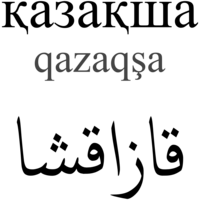| Kazakh | |
|---|---|
| қазақша or қазақ тілі qazaqşa or qazaq tılı قازاقشا or قازاق ٴتىلى قزاقشا or قزاق تلى | |
 | |
| Pronunciation | [qɑzɑqˈʃɑ] [qɑˈzɑq tɘˈlɘ] |
| Native to | Kazakhstan, China, Mongolia, Russia, Kyrgyzstan, Uzbekistan |
| Region | Central Asia (Turkestan) |
| Ethnicity | Kazakhs |
Native speakers | 16 million (2021 census)[1] |
| Kazakh alphabets (Cyrillic script, Latin script, Arabic script, Kazakh Braille) | |
| Official status | |
Official language in | Kazakhstan Russia
|
| Regulated by | Ministry of Culture and Sports Ministry of Science and Higher Education of the Republic of Kazakhstan |
| Language codes | |
| ISO 639-1 | kk |
| ISO 639-2 | kaz |
| ISO 639-3 | kaz |
| Glottolog | kaza1248 |
| Linguasphere | 44-AAB-cc |
 The Kazakh-speaking world: regions where Kazakh is the language of the majority regions where Kazakh is the language of a significant minority | |
Kazakh[a] is a Turkic language of the Kipchak branch spoken in Central Asia by Kazakhs. It is closely related to Nogai, Kyrgyz and Karakalpak. It is the official language of Kazakhstan, and has official status in the Altai Republic of Russia. It is also a significant minority language in the Ili Kazakh Autonomous Prefecture in Xinjiang, China, and in the Bayan-Ölgii Province of western Mongolia. The language is also spoken by many ethnic Kazakhs throughout the former Soviet Union (some 472,000 in Russia according to the 2010 Russian census), Germany, and Turkey.
Like other Turkic languages, Kazakh is an agglutinative language and employs vowel harmony. Kazakh builds words by adding suffixes one after another to the word stem, with each suffix expressing only one unique meaning and following a fixed sequence. Ethnologue recognizes three mutually intelligible dialect groups: Northeastern Kazakh—the most widely spoken variety, which also serves as the basis for the official language—Southern Kazakh, and Western Kazakh. The language shares a degree of mutual intelligibility with closely related Karakalpak while its Western dialects maintain limited mutual intelligibility with Altai languages.
In October 2017, Kazakh president Nursultan Nazarbayev decreed that the writing system would change from using Cyrillic to Latin script by 2025. The proposed Latin alphabet has been revised several times and as of January 2021 is close to the inventory of the Turkish alphabet, though lacking the letters C and Ç and having four additional letters: Ä, Ñ, Q and Ū (though other letters such as Y have different values in the two languages). Over one million Kazakh speakers in Xinjiang still rely on the Perso-Arabic script for writing. It is scheduled to be phased in from 2023 to 2031.
- ^ Kazakh at Ethnologue (27th ed., 2024)

- ^ "Статья 4. Правовое положение языков | ГАРАНТ".
- ^ "Произношение букв – kazaktili.kz" (in Russian). kazaktili.kz. Retrieved 12 December 2022.
- ^ "Kazakh (Қазақ тілі / Qazaq tili / قازاق ٴتىلى) – Omniglot". Retrieved 12 December 2022.
Cite error: There are <ref group=lower-alpha> tags or {{efn}} templates on this page, but the references will not show without a {{reflist|group=lower-alpha}} template or {{notelist}} template (see the help page).